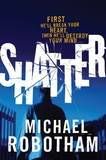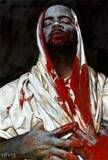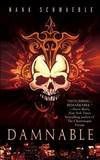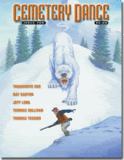Shatter / Michael Robotham
 Doubleday / March 2009
Doubleday / March 2009
Reviewed by: Rick R. Reed
Synopsis: It was Stephen King who talked me into reading Shatter. This is what he had to say in Entertainment Weekly:
“Gideon Tyler, the deranged villain of this exceptional suspense novel, is a devil so persuasive he's able to talk his victims into killing themselves. His opposite number, psychologist Joe O'Loughlin, must match wits with Tyler to save his wife and child from deaths almost too horrible to contemplate. Don't get into the second half of this book before that Green Day concert, or you'll end up staying home to see how it all comes out.”
Review: When Stephen King praises a suspense novel, I think I’ll take notice. And I definitely think I will have to pick up more of Michael Robotham’s work. Shatter is a book that offers readers such original and delightful shades of darkness and light that I wondered when I had last been so impressed.
And then I remembered. The last time I was so duly impressed was when I first read Thomas Harris’s Silence of the Lambs. Robotham, with his villain, Gideon Tyler, has created such a deliciously demented—and brilliant—character that I couldn’t help but get caught up in the evil he was perpetrating. Much like Thomas’s Hannibal Lecter, Tyler is so whacked out, but so smart, he is truly a monster, but a monster we cannot bear to look away from. And what this monster does is so quietly horrendous that it ventures into nightmare territory. Having worked in secret military forces, Tyler is a master of manipulation, and knows exactly what buttons to push to get his victims to do his bidding, up to and including suicide. We get a front-row seat to his techniques and you may balk at the notion that a human being can compel another happy, well-adjusted human being to commit suicide…until you read this book. Gideon Tyler is that mesmerizing and that clever. Robotham makes Tyler’s persuasive techniques completely credible and the book is all the more chilling for it.
Robotham’s hero, Joe O'Loughlin, is, in my opinion, an even more original creation than Harris’s Clarice Starling, and perhaps, in his own way, more sympathetic and compelling. A psychologist, O’Loughlin get pulled into Gideon Tyler’s web when he first gets involved at the behest of his local police force to help talk down a woman who is about to jump to her death from a bridge. We know right away that this is no ordinary suicide and it isn’t long until O’Loughlin—and his family—are pulled into the monster’s web. What makes O’Loughlin so believable and sympathetic is that he’s one of us: an ordinary, flawed man who worries about his children, his marriage, and his future. And I am pretty sure that Robotham here has created the first, or at least one of the first, heroes with Parkinson’s Disease.
Shatter really has it all when it comes to the thriller genre: it’s fast-paced, has uniquely and wonderfully-drawn characters, contains a great mystery at its center, and makes you want to read more from Michael Robotham. If his other stuff is even a fraction as good, you’re in for some breathtaking suspense.
Purchase Shatter by Michael Robotham.
Columnist Rick R. Reed is the author of ten novels and has short fiction in more than twenty anthologies. He lives in Seattle, WA. Find out more about the author at his website.
Valley of the Dead / Kim Paffenroth
 Cargo Cult Press / August 2009
Cargo Cult Press / August 2009
Reviewed by: Blu Gilliand
Even before Pride and Prejudice and Zombies became all the rage, author/editor Kim Paffenroth (Gospel of the Living Dead, History Is Dead) was making his own study of a literary masterpiece under a warped lens. But rather than have zombies stumble into the tearoom of a Jane Austen novel, he marched them directly into the path of Dante, famed poet and architect of Hell. The result: Valley of the Dead.
The fact that I’ve read more about Inferno, the volume of Dante’s The Divine Comedy focused on Hell, than the work itself did not in any way detract from my enjoyment of Paffenroth’s novel. Each chapter begins with the lines of the poem that tie in to it, which allowed me to get the connections Paffenroth is making without having Dante’s text by my side. I’m sure familiarity with Inferno would make this an even richer and more satisfying read, but don’t let unfamiliarity put you off – Paffenroth’s work is just as accessible as a straight-ahead horror story as it is a literary companion piece.
The story goes that Dante, wandering in exile from his homeland, was inspired by the terrible conditions of plague and famine he encountered to create his famous vision of Hell. In Paffenroth’s vision, the plague is one of the living dead, maurading through villages and slaughtering their inhabitants. It’s Dante’s encounters with these creatures, as well as the army of men cutting down anything – and anyone – in their path to contain them, that fuel his ideas of cannibalism, death and despair.
In quick fashion, Paffenroth teams Dante up with a disparate (and desperate) group of co-adventurers – a repentant soldier, a tough-as-nails pregnant woman, and a monk from a mysterious, ancient order. Together, they travel through the dangerous countryside, seeking safe passage from the thick of the infestation. The book quickly settles into a kind of macabre road trip, one with plenty of action, a fair dollop of gore, and some really strong character work.
Paffenroth’s writing career, which began with the Bram Stoker-winning Gospel of the Living Dead, has been firmly centered in the world of the undead for quite some time now. Much like Brian Keene, he’s been able to build a solid reputation for taking the once-thought-dead zombie subgenre and infusing it with, for lack of a better term, new life. With Valley, he brings that fresh perspective not only to zombies, but to a literary classic as well. Valley of the Dead is that rare work that can appeal to fans of splatter and classic literature at the same time. If it ever lands a mainstream release, it’s going to be a tough shelving decision for some bookstores.
Purchase Valley of the Dead by Kim Paffenroth.
Urban Gothic / Brian Keene
 Leisure Books / August 2009
Leisure Books / August 2009
Reviewed by: Joan Turner
Readers familiar with Brian Keene’s fiction know his work is raw, gritty and often brilliant, and his latest novel, Urban Gothic, is no exception. In a hard-core horror fright fest, Keene drops readers into the depths of one of the darkest and most tortuous nightmares imaginable.
The story begins simply enough. Three young couples are on their way home from a rap concert in Philadelphia when their car breaks down in a bad neighborhood in the inner city. They are approached by a group of black youths whom they stereotypically mistake for criminals. Unnerved by their presence, one of the young men yells a racist slur. Fearing reprisal, the six friends abandon the car and take refuge in an old decrepit and seemingly abandoned house nearby.
But the house is far from abandoned. The place has a long and well-deserved reputation as the neighborhood’s haunted house for those who enter it are never seen again. But something far more sinister than ghosts occupies this dwelling. The house is a death trap inhabited by bloodthirsty cannibalistic humanoids, and the six young friends must struggle for their lives against inconceivable odds.
The visceral mayhem and violence of Urban Gothic is shocking, and the atmosphere and mood of the old dark house and the despair of the victims, soon separated from one another and lost as they flee the killers, adds to the horror.
The cinematic possibilities of this story are readily apparent, but this story is far from the mindless slasher plots of too many B grade films. Keene offers powerful social commentary by breaking stereotypical expectations and injecting the rationale that bad situations can bring out the best in people.
Winner of two Bram Stoker Awards, Brian Keene burst onto the horror scene with his 2003 debut novel The Rising, and his momentum continues to grow with this, his most powerful novel to date. Urban Gothic is a tour de force in shock horror. Read it if you dare.
Purchase Urban Gothic by Brian Keene.
Damnable / Hank Schwaeble
 Jove / August 2009
Jove / August 2009
Reviewed by: Martel Sardina
Jake Hatcher gets sprung from military prison in order to attend his brother Garrett’s funeral, which is shocking considering Jake never knew that he had a brother. Upon his release, Hatcher heads to New York City intent on getting some answers. Why did his parents keep Garrett a secret? How did Garrett end up dead? The answers to those questions leave Hatcher wanting to know more about the brother he never knew.
Hatcher consults with Detective Wright. Turns out Garrett died trying to save a beautiful stranger named Deborah. Hatcher gets the feeling that the police are being less than truthful about the circumstances surrounding Garrett’s death, so he decides to do some investigating of his own. Trouble is, for every answer Hatcher gets, another question is raised. The puzzle pieces aren’t fitting together. Garrett’s friend, Fred, is a paranoid conspiracy theorist and isn’t sure whether or not he should tell Hatcher what he knows. And then there’s Susan, Garrett’s pregnant girlfriend, who happens to be married to another man.
Meanwhile, Detective Wright has her hands full with a series of missing persons’ cases. A pattern emerges revealing that many of the “victims” are hookers. Lucas Sherman, a known serial rapist, is a suspect but winds up being released from custody thanks to his high priced attorney, Stephen Solomon – legal counsel Sherman can afford thanks to his employer, Demetrius Valentine.
Valentine is the one who is up to no good. Sherman finds the hookers and brings them to Valentine. Valentine needs them to train the monster he’s created, the “Get of Damnation” to prepare it for its unholy purpose.
As Hatcher digs deeper, he discovers that Deborah, the woman Garrett saved, is not as innocent as she first seemed. Who is she? Or perhaps, what is she? And how is she connected to Sherman and Valentine?
Demon stories are generally a hard sell for this reviewer – primarily because many of them are misogynistic and contain graphic descriptions of rape and abuse that are not integral to the plot of the story. While Damnable does contain some of these elements, Schwaeble makes a concerted effort to tie those elements to plot and avoids being gratuitous.
Damnable is Hank Schwaeble’s debut novel. While a thriller at its core, it contains enough of a horror element that it should please fans of both genres. Highly recommended for readers who enjoy supernatural mystery.
Purchase Damnable by Hank Schwaeble.
“Teddy Bears and Tea Parties” / S. Boyd Taylor
 from ChiZine #41 / July 2009
from ChiZine #41 / July 2009
Reviewed by: Anthony J. Rapino
Playing out like a twisted fairy tale, “Teddy Bears and Tea Parties” leads the reader through a dark forest peppered with breadcrumb trails of cryptic references and surreal descriptions. We find ourselves in a world where “the magic came back,” bringing with it living picture frames, hungry houses, and an army of teddy bears.
Little Girl is trapped in a house with the razor-clawed, vampire-fanged teddy bears. In order to stay alive she systematically slices them up and feasts on their blood, which is made of different types of jelly; her favorite is Concord grape. Like the houses, picture frames, and teddy bears, Little Girl is very hungry.
She needs to find out where her sister, Angie, has been taken, though she’s certain an eyeless man, Hymn, has something to do with it. Once she finishes off the teddy bears and runs out of jelly-blood to eat, she is forced to confront Hymn. The story delves deeper into magical realism as Hymn swallows Little Girl whole. Inside his cavernous eye-lined body, she finds a massive tea party populated by dolls, one of which is her sister. They attempt to fight their way to freedom against more teddy bears and the inner workings of Hymn.
S. Boyd Taylor manages to take these many hallucinogenic bits – akin to a bad dream after reading an innocuous bedtime story – and close with satisfactory reasoning and a lingering sense of dread. As you read the last lines, noting the sudden rhythm and rhyme, you again may be reminded of a children’s book gone horribly wrong. And this reviewer means that in the very best of ways.
Read “Teddy Bears and Tea Parties” by S. Boyd Taylor.
Martyrs & Monsters / Robert Dunbar
 DarkHart Press / March 2009
DarkHart Press / March 2009
Reviewed by: Joan Turner
The pianist John Mehegan once said that a good jazz musician should be able to play any tune in all twelve keys, recounts mystery writer Evan Hunter (Ed McBain) in his book McBain Duet. Hunter went on to say that he believed the same thing held true for writers, that a good writer should be able to crawl into the skin of a male murderer in Manhattan or a female librarian in Dubuque, Iowa, or be able to become a Masai warrior, a truck driver or any character he chose to convey. That achievement requires far more than the ability to string words on paper, it requires the skill of a master craftsman. Robert Dunbar has that skill, and his powerful new collection, Martyrs & Monsters, bears witness to the fact. Whether writing about traditional monsters like vampires and werewolves or modern day horrors, Dunbar’s characters breathe life into the stories, pulling the reader in and holding him as suspense mounts until the conclusion.
Martyrs & Monsters is a thrill ride in psychological horror. Readers familiar with the author’s longer works, The Pines, a novel that took the genre by storm and was hailed by many as the catalyst for the new literary movement in horror, and his strong follow up novel, The Shore, will find his short fiction equally intense and effective. Dunbar is a literary stylist who brings to his writing a deep understanding of human nature and genuine compassion for his characters.
Characters or subjects link some of the stories. “Are We Dead Yet” introduces readers to the gay lovers, Con and Tim, and plants seeds of disaster in their co-dependent and dangerous relationship that bursts into bloom in “Getting Wet.” “Red Soil,” recounts the horrors of a mother’s sacrifice and is prequel to “Gray Soil,” both reaching back to the common origins of vampires and zombies, and the two lost boys of “Like a Story” go on to become the tragic protagonists of “Killing Billie’s Boys.” These continuing stories are among the strongest in the collection.
Another outstanding tale, Dunbar’s evocative “Mal de Mer,” in a style reminiscent of classics such as Jackson’s “The Haunting Hill House,” recounts the heroine’s descent into madness. Yet as tragic as many of the stories are, a thread of hope runs throughout the stories.
In a lighter vein, one selection, “The Folly,” is a darkly humorous tale of a once wealthy southern family living in a crumbling alligator shaped mansion in the swamp who are both terrorized by and obsessed with a monster.
Martyrs & Monsters is a masterpiece, a well-written and disturbingly satisfying body of work that not only displays the range and depth of the author’s ability, but brings more literary credibility to the genre Robert Dunbar continues to help shape.
Purchase Martyrs & Monsters by Robert Dunbar.
“The Devil Came to Mamie’s on Hallowe’en” / Lisa Morton
 from Cemetery Dance #60 / May 2009
from Cemetery Dance #60 / May 2009
Reviewed by: Anthony J. Rapino
I once read that the two most important lines of a story are the first and last. If this is true, “The Devil Came to Mamie’s on Hallowe’en” starts beautifully with a whopper of a first line: “It was Hallowe’en night, and business was slow at the whorehouse.”
We meet Leona, a levelheaded sixteen-year-old who plays piano and sings for Mamie’s whorehouse. While everyone around her is superstitious, Leona remains unconvinced that Jacky-Ma-Lantern is wandering around on Hallowe’en night. Or that a hoodoo man is capable of bringing a dead boy back to life. So when Lizzie – a fellow working girl who fails to return before sunset and eventually shows up bloodied and stinking – claims to have summoned the devil himself, Leona is not fooled.
Lizzie explains that the devil granted a wish for her, and that a handsome, rich man will come to take her away that very night. Leona’s grip on reality is shaken when a man does show up with a marriage proposal for Lizzie, and her strength is further tested when her own dreams are offered for the taking.
Morton excels at creating a rich setting for her characters to take root. She carefully weaves superstitions and folktales into the narrative, all the while creating a new story from their ashes. Like Robert Johnson meeting the devil at the crossroads, Morton’s own telling feels as if it could have happened just as she describes.
Purchase Cemetery Dance #60 with “The Devil Came to Mamie’s on Hallowe’en” by Lisa Morton.




